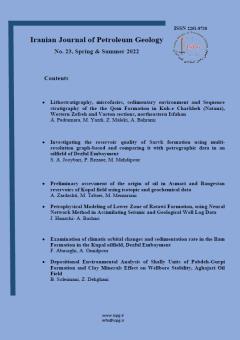Depositional Environmental Analysis of Shally Units of Pabdeh-Gurpi Formation and Clay Minerals Effect on Wellbore Stability, Aghajari Oil Field
Subject Areas : Petroleum Geologyبهمن سلیمانی 1 , Zahra Dehghani 2
1 - Petroleum Geology and Sedimentary basins, Earth Science Faculty, Shahid Chamran University of Ahvaz.
2 - Department of Geology, Science and Research branch, Islamic Azad University, Tehran, Iran. Zahra.dehghani20@gmail.com
Keywords: Wellbore stability, NGS log, Pabdeh-Gurpi Formation, sedimentary environment, Aghajari oilfield. ,
Abstract :
This research is related to detect of clay minerals and geochemical changes of Pabdeh-Gurpi shale formations and their role in borehole instability in Aghajari oil field. For this purpose, these formations were investigated using NGS well log (one well ring), X-ray diffraction method (XRD) and XRF analytical method (11 samples from two wells). In the NGS log, the detected minerals are illite, montmorillonite, mixed layer, glauconite and feldspar. In the XRD method, clay minerals illite, montmorillonite, mixed layer, chlorite and kaolinite were identified in order of abundance.These minerals due to their sensitivity to react with water causes the instability of the borehole. The high ratio of Si/Al and changes of Ti and high level of Fe3+ and Mg are also a sign of the widespread presence of illite, chlorite and montmorillonite in the mentioned formations.
The changes of major and trace elements compared to Al2O3 except for MnO, CaO, and P2O5 showed a positive linear relationship. The changes in the amount of Fe2O3 show the oxidizing conditions in the upper part of the base, but the reducing conditions towards the upper side. Based on the amount of iron, manganese and vanadium, the sediments were formed under conditions of reduction, non-sulphide reduction Eh and medium to low pH. Variations in Th/U ratio (1-4.5) indicate marine to transitional environments. The existence of horizons rich in organic matter (more than 2%) confirms the reduction conditions.
Based on the low values of the Zr/Rb ratio, the sediments in the upper and lower parts are finer than the middle part of the grain. The relative accumulation of biogenic carbonate along with the shale is periodic and is reflected in the changes in the (Zr+Rb)/Sr ratio. Based on the Sr/Ba ratio, marine conditions prevail in the lower part and continental and metamorphic and sometimes marine conditions prevail in the upper part of the formation. Oxidation-reduction conditions were also investigated. The values of the V/(V + Ni) ratio of the semi-reduction region, the Ni/Co ratio of the reduction region and the V/Cr diagram show the almost reduction region and in some cases the oxidant conditions. Paleoclimatic conditions at the time of sedimentation based on low values of Rb/Sr ratio (less than 0.14) were completely hot and dry.
